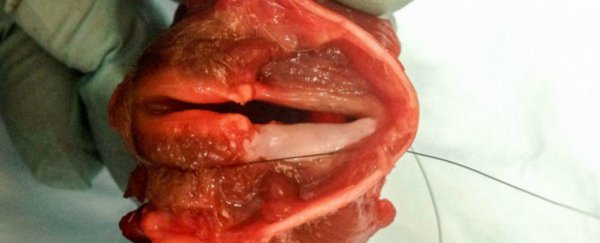For the first time, researchers have grown vocal cord tissue in the lab that can produce sound when transplanted into animals. Importantly, the bioengineered tissue showed no signs of being rejected by animal models, which makes it a good candidate for future transplants to give a voice back to those with vocal cord damage as a result of illness or surgery.
"It's an exciting finding because those patients are the ones we have very few treatment options for," Jennifer Long, a voice doctor at the University of California, Los Angeles, who wasn't involved in the study, told Emily DeMarco over at Science.
Our vocal cords are two strong but flexible bands of muscle that are covered in a delicate tissue called mucosae. When we speak, we force air over them, causing them to vibrate against each other and produce sound.
Most people's vocal cords vibrate around 100 to 200 times a second – in soprano singers that can get up to 1,000 vibrations per second – but patients with vocal cord damage often can't reach 100 vibrations a second, which means they struggle to produce sound.
And it happens to more people than you might expect, with 20 million people in the US alone suffering from temporary or permanent loss of voice, often as a result of surgery to remove cancerous or benign growths in the throat.
"I can't overemphasise just how negatively a severe voice problem can impact someone's life," co-author Nathan Welham from the University of Wisconsin School of Medicine and Public Health in Madison told Science. "If you have a really poor voice, it draws attention immediately when you open your mouth."
But finding a way to create vocal cord tissue in the lab proved incredibly challenging. "Our vocal cords are made up of special tissue that has to be flexible enough to vibrate, yet strong enough to bang together hundreds of times per second," Welham said in a press statement. "It's an exquisite system and a hard thing to replicate."
The team started by taking vocal cord cells from a cadaver, as well as four non-cancerous patients who'd had their larynges removed. From this tissue, they isolated the two types of cells that make up the mucosae – connective fibroblasts and epithelial cells – in a petri dish, before applying them to a 3D collagen scaffold.
After two weeks, these cells had formed a complex structure that looked and behaved just like normal vocal cord tissue.
To test it out, the team transplanted the bioengineered tissue onto one side of larynges taken from deceased dogs. When air was pushed through these larynges, the vocal cords made sound, and high-speed imaging showed that the artificial tissue was vibrating just like a natural vocal cord.
The tissue was then transplanted into mice engineered to have human immune systems and, amazingly, it wasn't rejected. "It seems like the engineered vocal cord tissue may be like cornea tissue in that it is immunoprivileged, meaning that it doesn't set off a host immune reaction," said Welham.
In fact, the only real difference between the lab-made and natural vocal cord tissue was that the natural tissue was more mature, but the researchers explain that his makes sense, given the fact that the vocal cords continue to develop at least 13 years after birth.
The challenge now is to transplant this tissue into a living animal and have it survive and function, before finally demonstrating the same thing in long-term clinical studies in humans.
Researchers also need to establish a reliable supply of vocal cord cells, as it's hard to find removed larynges that aren't cancerous. Other teams are now trying to find a way to turn stem cells directly into vocal cord cells in the lab, which would solve the problem.
There's still a long way to go, so don't expect to have your doctor offering your a vocal cord transplant anytime soon. But the fact that it's now inside the realm of possibility is incredibly exciting for all the people out there without a voice.
The research has been published in Science Translational Medicine.

